Tested: AMD's Windows 11 Patch Wins Some, Loses Some
High latency bug hits fast
Update: We've added testing and commentary below to reflect our updated testing with both the Windows 11 and AMD chipset driver patches that became available last week.
Our real-world game testing didn't find any large performance changes, as some games benefit from the patches while others lose a slight amount of performance or remain the same, balancing out any gains in our overall measurements below.
We found that synthetic measurements of AMD's L3 latency and fabric have returned to normal. We still see a small reduction in L3 bandwidth measurements in Windows 11, but these don't appear to have a performance impact in most of our tested games. Read on for the updated article:
Amended article:
A few weeks ago, we put a few of the leading AMD Ryzen chips from our Best CPUs for gaming list through several gaming benchmarks and targeted tests to see the extent of the Windows 11 bug that reduced performance on AMD's processors. The patches became available last week, so we've also now updated the article with testing to show the impact.
AMD's original announcement that it and Microsoft were jointly investigating two performance-sapping bugs in Windows 11 was an eye-opener, especially since they impacted all Windows 11-compatible AMD processors, which AMD said reduced gaming performance by up to 15% in some eSports titles and 3-5% in desktop PC applications.
The original issue appeared to be quite severe, at least in synthetic benchmarks. As you'll see in our extensive CPU Benchmarks below, we found that AMD's L3 latency could be as much as six times higher in Windows 11 compared to Windows 10, and that L3 bandwidth was up to 12X higher in Windows 10. However, we didn't see such severe impacts in our gaming tests, with our biggest Windows 10 vs 11 differences weighing in at 7% in one game title, while others are far more muted. Notably, we tested with the first Windows 11 update that actually made the bug worse.
We've since followed up with patch testing and found that most of the games on the fully-patched system are within 2% of pre-patch performance. The bug impacts chips with more than eight cores the most, so we used the 12-core Ryzen 9 5900X that dominates our CPU Benchmark hierarchy to test the patches.
Get Tom's Hardware's best news and in-depth reviews, straight to your inbox.
We did find that one title, Project Cars 3, is 7.5% faster after the patch, while Shadow of the Tomb Raider is 6.7% slower. Overall, the performance gains and losses across the full gamut of our tests amounted to a wash. Meanwhile, the synthetic L3 cache and bandwidth measurements improved dramatically.
Frankly, the bugs couldn't have come at a worse time: Intel is on the cusp of launching its seemingly-potent Alder Lake chips that could swing the advantage back in its favor. Making things worse for AMD, Windows 11 has new scheduler optimizations specifically for Alder Lake, so reviewers will use the new operating system for testing. That raised concerns that the bug could possibly result in unfair comparisons, but the quick resolution has at least removed that concern.
However, Intel did tout gaming performance benchmarks with Alder Lake against AMD's Ryzen 9 5950X last week. Intel divulged that it tested the 5950X before the patches were available, leading to accusations that the benchmarks weren't representative of the true differences between the two chips.
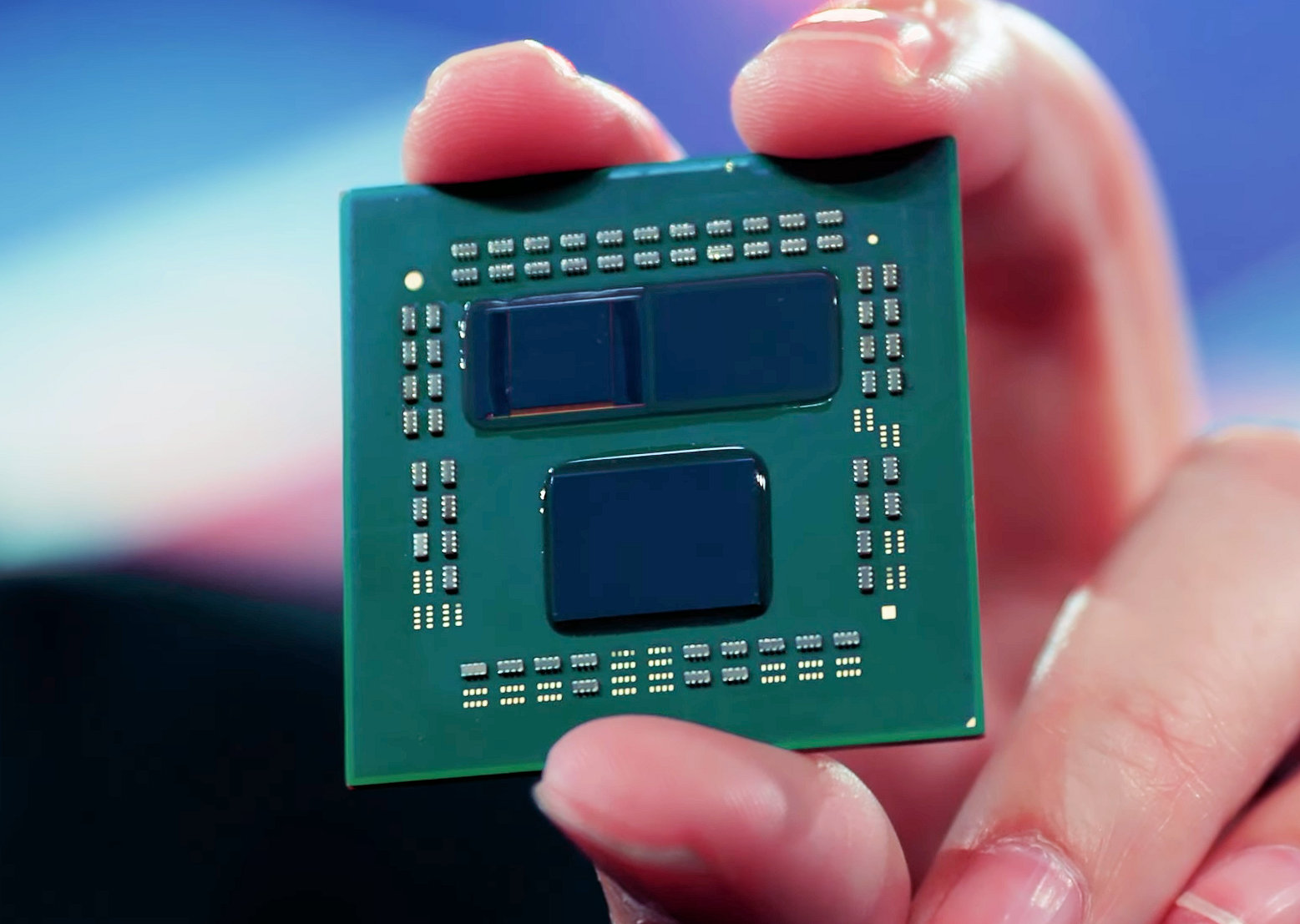
It's surprising that two severe bugs squeezed past both AMD and Microsoft's QA teams — the first reports of the L3 bug popped up in forums several months ago as enthusiasts tested the pre-release Windows 11 builds. AMD also reported that its UEFI CPPC2 (Collaborative Power and Performance Control 2) feature, a technology that helps to steer lightly-threaded work to the fastest cores on the chip, also has issues that can impact lightly-threaded applications (like games). AMD says this bug is more detectable in chips with more than eight cores and >65W TDP. (Notably, these issues are separate from the performance issues surrounding Microsoft's recommended VBS and HVCI security settings that have caused an outcry. We recently put those issues to the test.)
AMD and Microsoft jointly investigated the issue, and a software update to fix the CPPC2 issue and a Windows Update to remediate L3 latency problems were delivered last week (full details here).
Windows 10 vs Windows 11 Gaming Performance Benchmarks
We tested with Windows 11 Pro 23000.258 and the Windows 11-compatible Nvidia 472.12 graphics driver (the latest driver arrived after testing was complete). As always for CPU testing, we used an Nvidia GeForce RTX 3090 to minimize the graphics bottleneck. We also stuck with a 1920x1080 resolution, so be aware that the impact of the bug will vary with different resolutions and graphics cards. We have also tested with a limited selection of games, so be aware that performance deltas could vary with other titles.
| Tom's Hardware | Ryzen 9 5900X / Win11 + Chipset Patch | Ryzen 9 5900X / Win11 Patch Only |
| Project Cars 3 | +7.5% | +4.6% |
| Shadow of the Tomb Raider | -6.7% | -2.8% |
| Dota 2 | +2.9% | Even |
| Strange Brigade | +2% | +1.5% |
| Red Dead Redemption 2 | Even | Even |
| Far Cry 5 | -1.5% | Even |
| Grand Theft Auto V | Even | Even |
We have the full breakdown of gaming testing below, but the above table summarizes the issue well. We retested gaming on the Ryzen 9 5900X with the Windows 11 patch only (Win11 Patch Only- far right), and then with both the Windows 11 patch and the AMD chipset driver (Win11 + Chipset Patch - both are required to patch the issues fully).
The Windows 11 patch, which corrects the L3 issue, resulted in a 4.6% gain in Project Cars 3 and a very minor 1.5% gain in Strange Brigade, while Shadow of the Tomb Raider declined by 2.8%. The remaining four titles scored within a single percentage point, which we consider a tie.
Adding in AMD's new chipset driver, which patches the thread-targeting feature that boosts performance in lightly-threaded workloads (like games), adds a bit more to both the gains and losses. For instance, Project Cars 3 improves by a few more percentage points, while Shadow of the Tomb Raider loses another ~4%. Notably, DOTA 2 is also slightly faster with the AMD chipset driver.
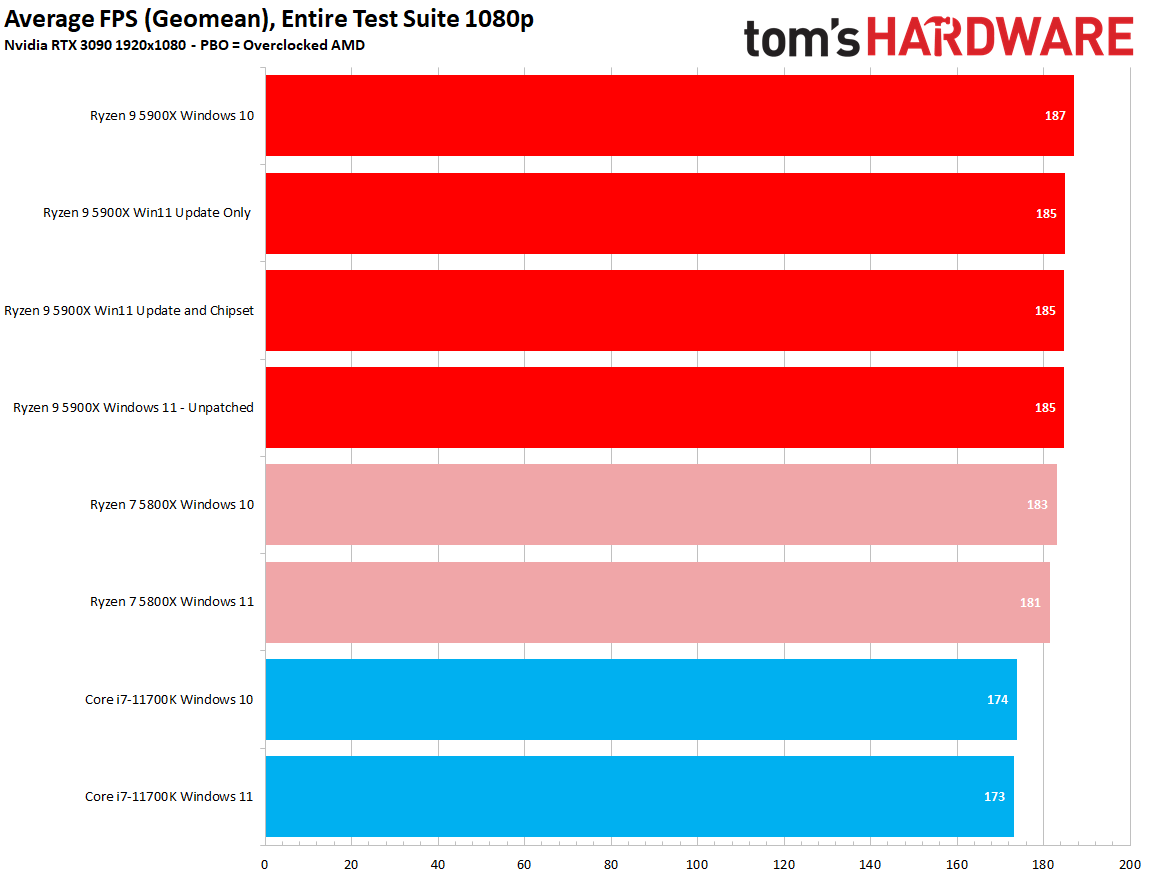


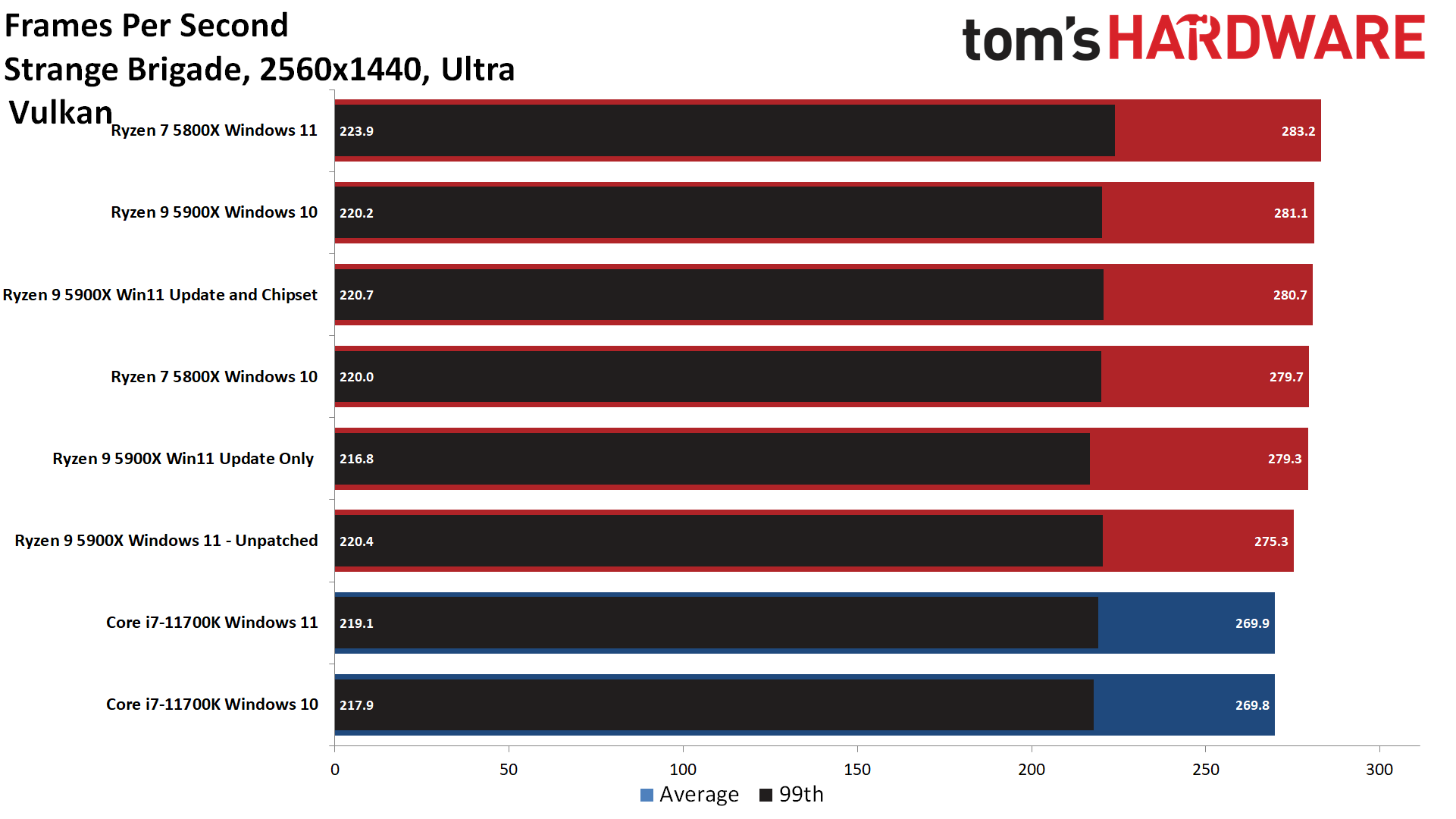
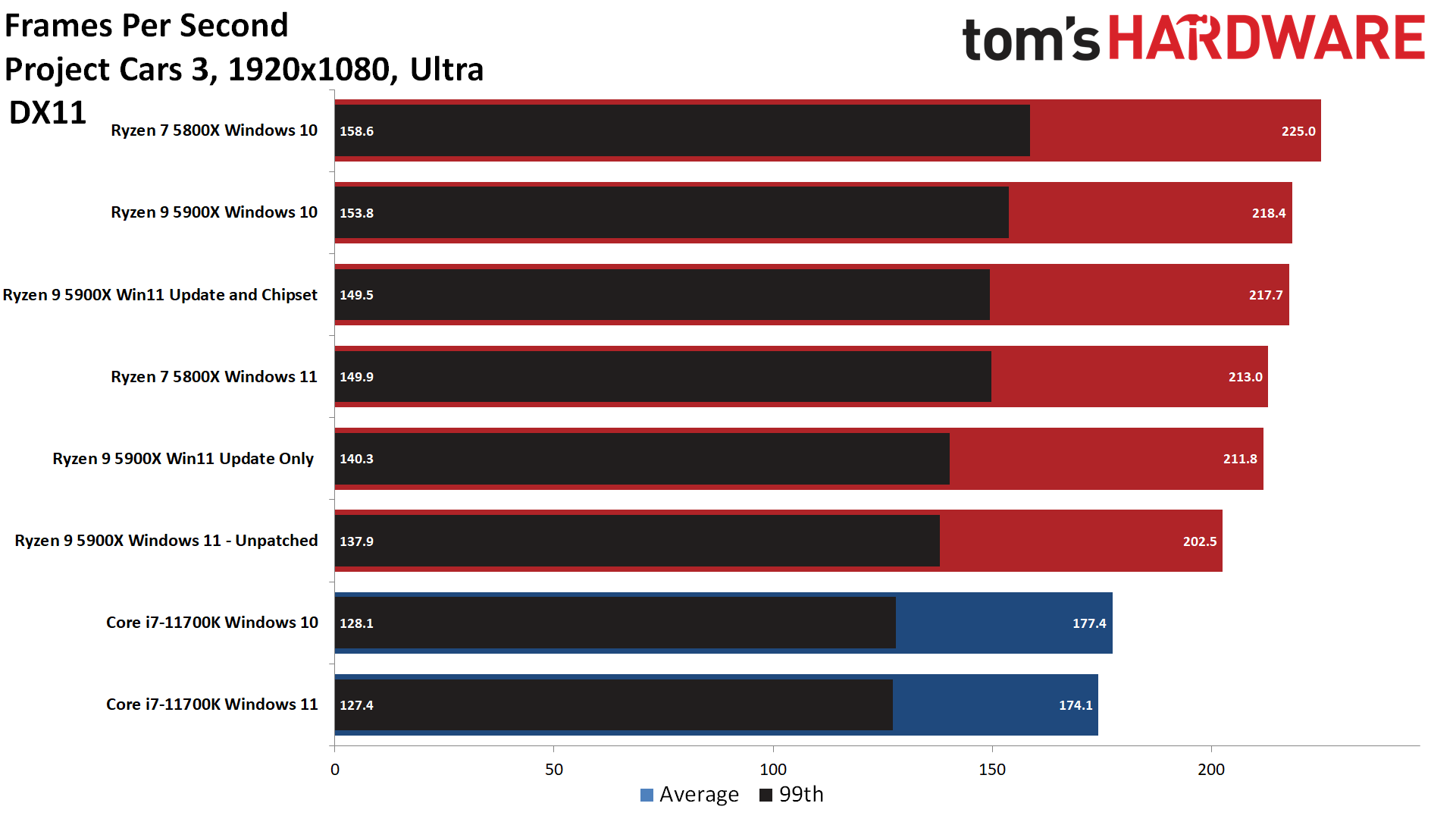
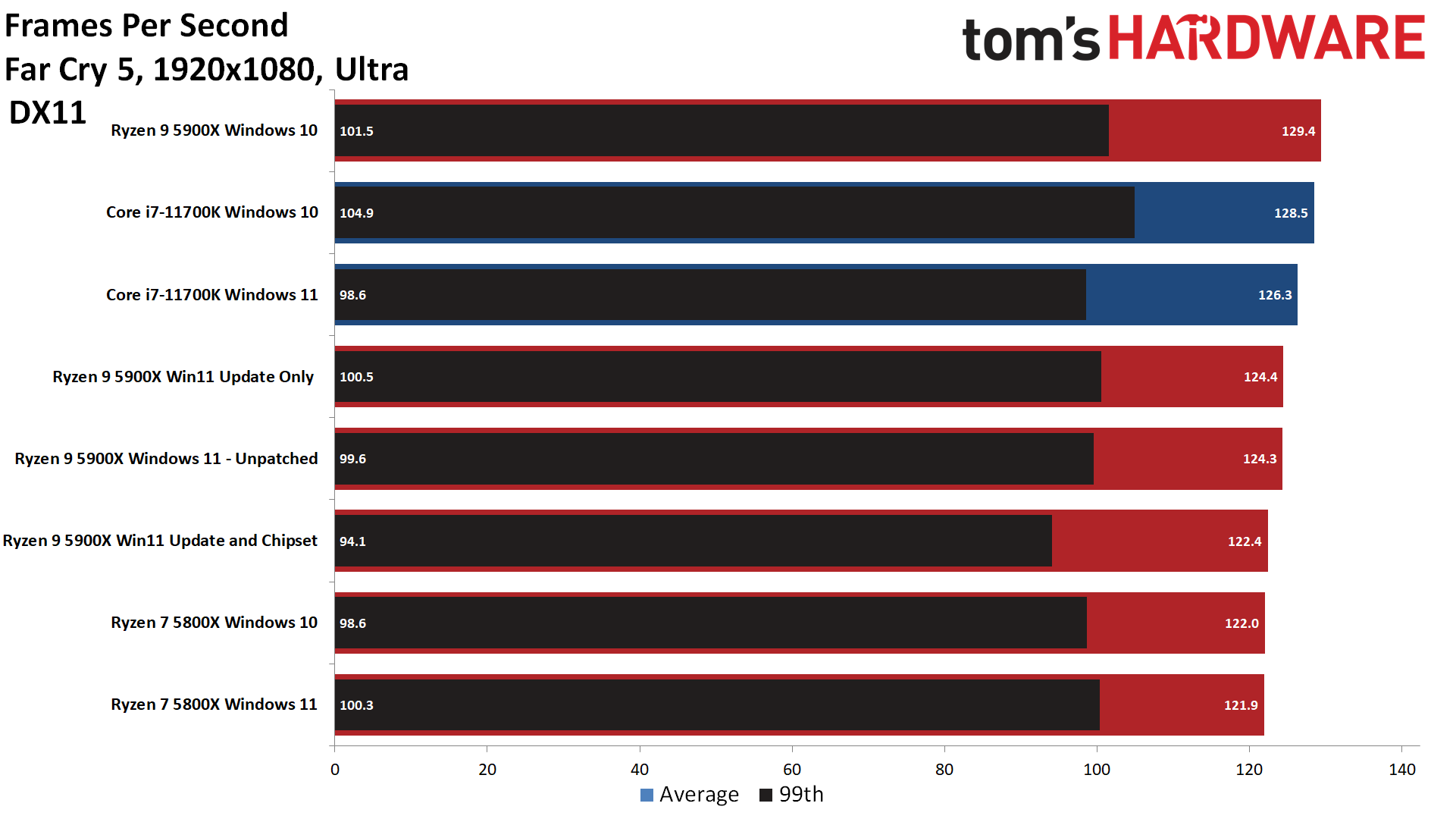
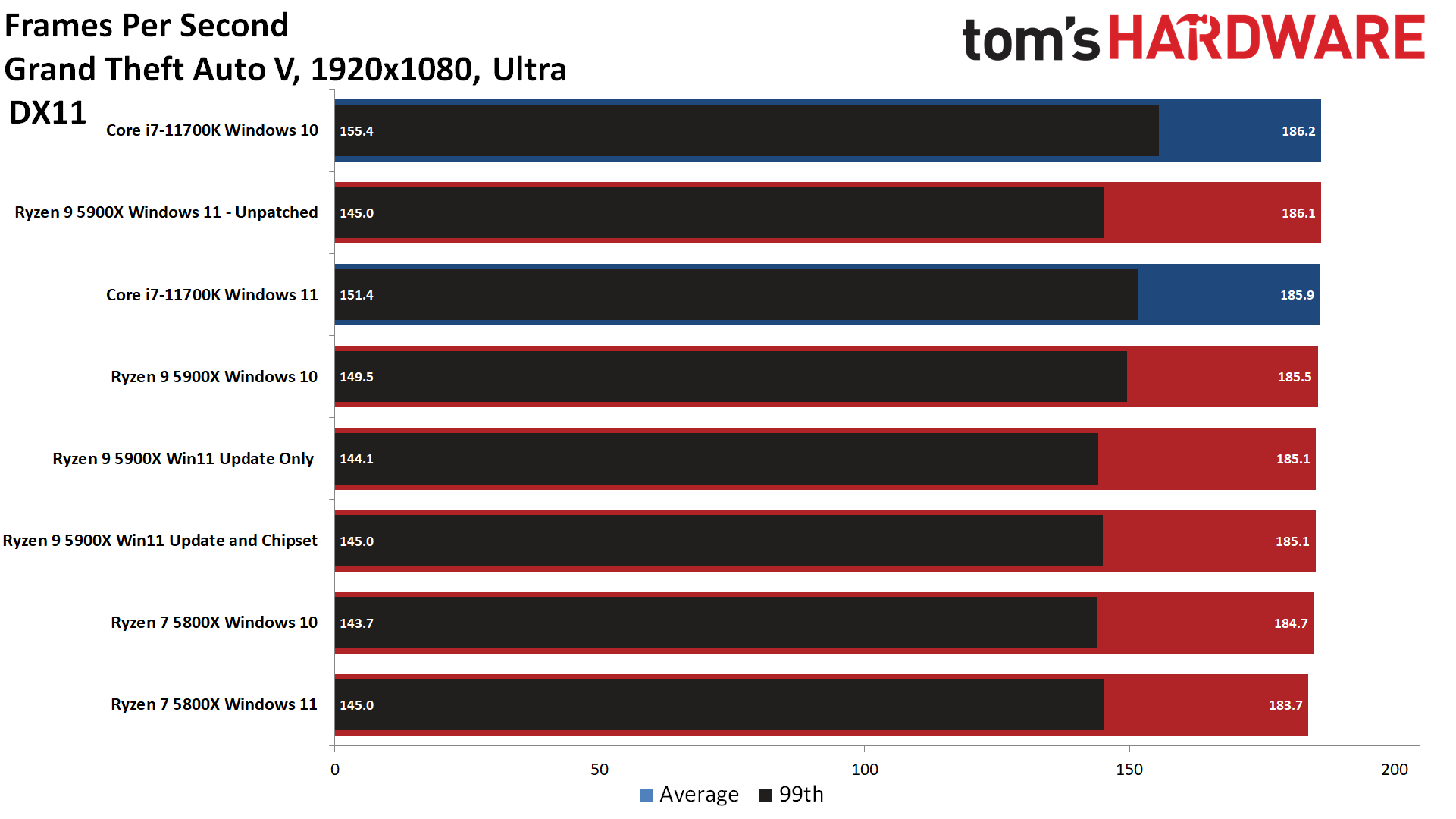
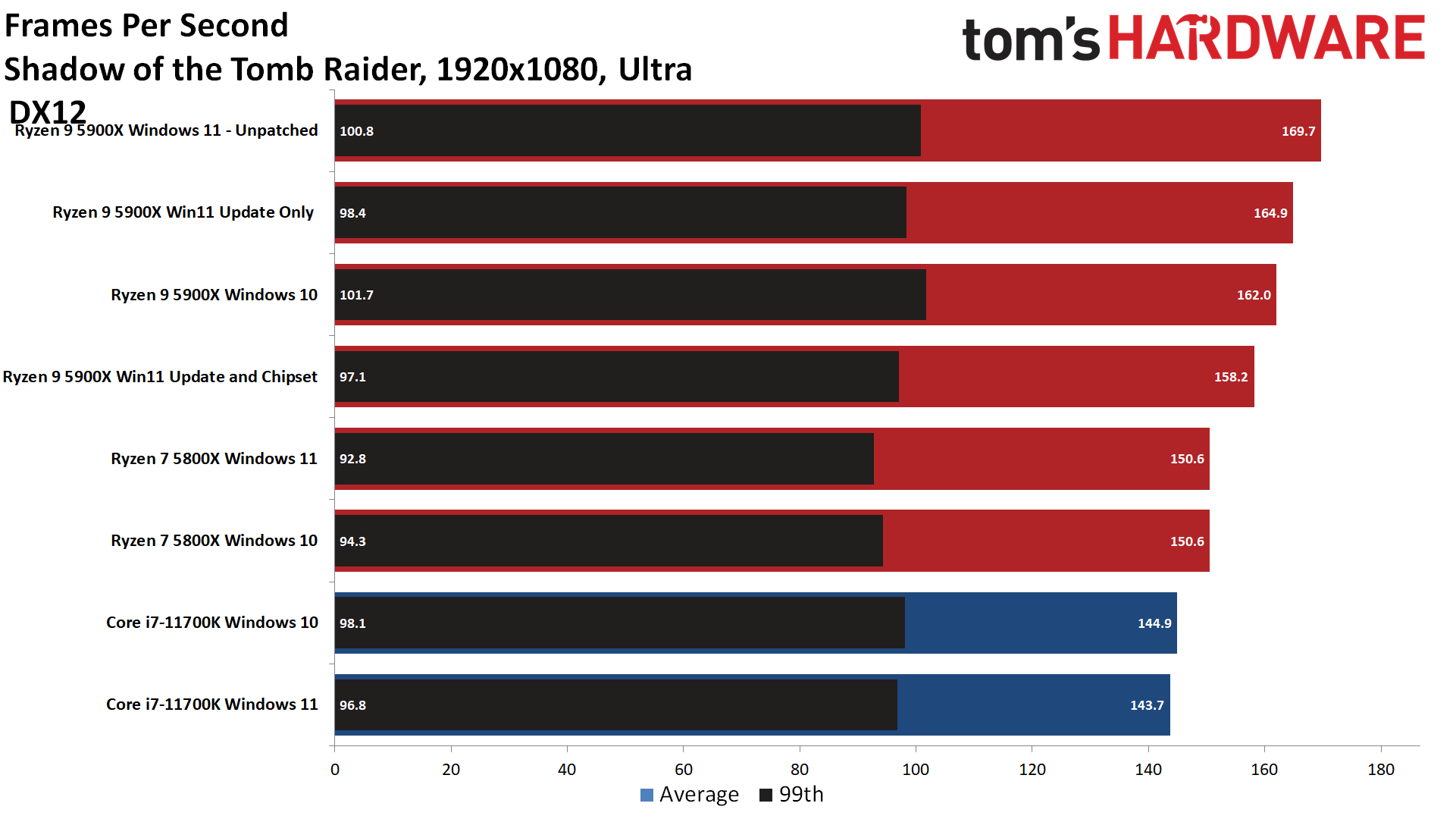
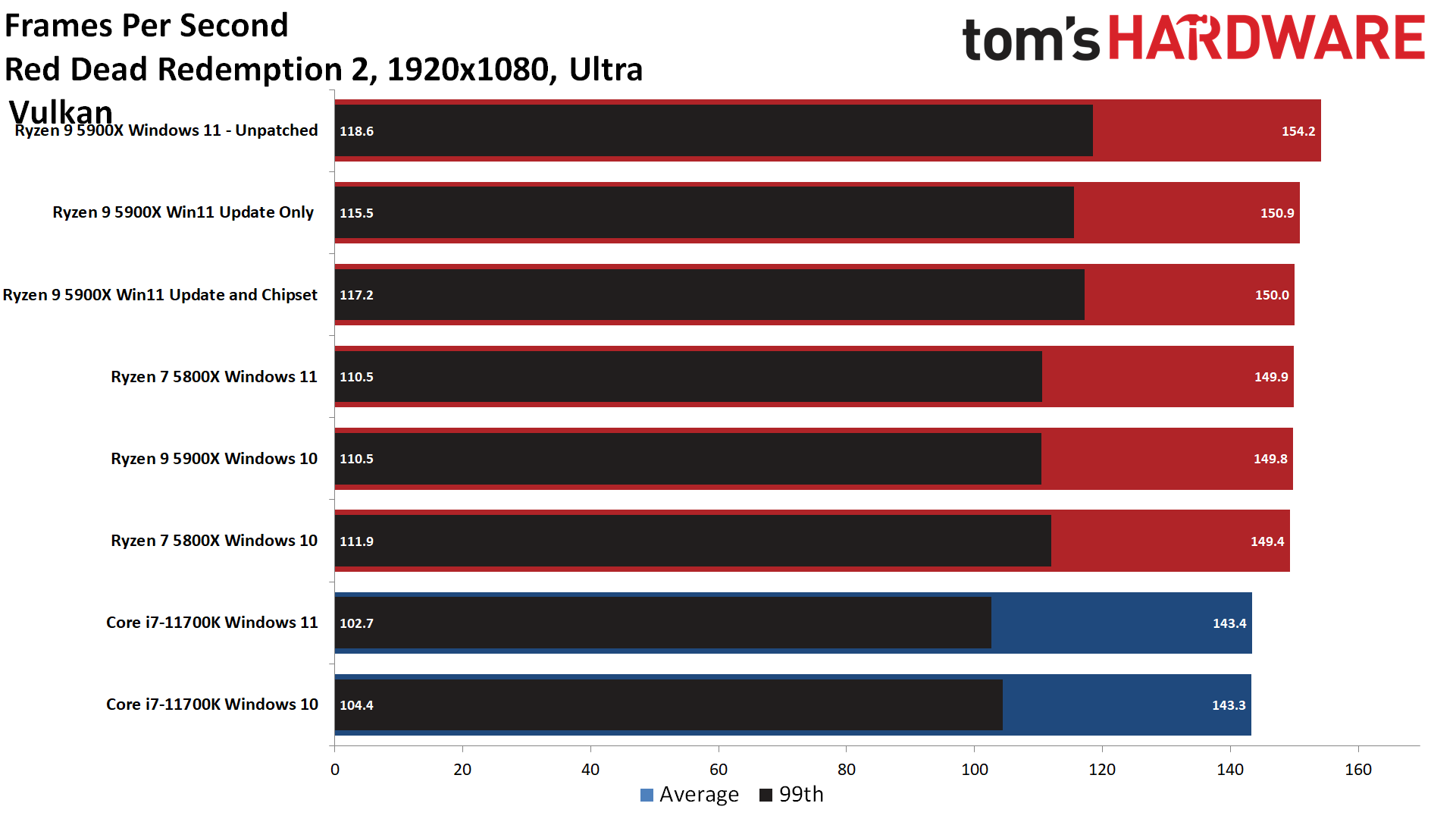
The first two charts in the album above show the geometric mean across the seven tested titles. Windows 10 is still slightly faster overall (one percent isn't meaningful), but average fps landed within a single frame for the pre-patch and post-patch Windows 11 configurations. We see a similar result in the overall measure of 99th percentile framerates. As noted in the table above, there are more pronounced differences in some individual titles, which you can also see in the album.
We used a Core i7-11700K as a comparison point to give us a general idea of the expected variances from the operating system change. However, be aware that game code and drivers respond differently to the respective CPU architectures, making the 11700K a crooked measuring stick, at best.
| Tom's Hardware | Ryzen 9 5900X Win11 + Chipset Patch | Ryzen 9 5900X Win11 Patch Only | Ryzen 9 5900X / Unpatched | Ryzen 7 5800X | Core i7-11700K |
| Project Cars 3 | Even | -3.2% | -7.3% | -5.3% | -1.9% |
| Shadow of the Tomb Raider | -2.3% | +1.8% | +4.8% | Even | -0.8% |
| Dota 2 | Even | -2.6% | -2.9% | -1.4% | +1.9% |
| Strange Brigade | Even | -0.6% | -2.0% | -1.2% | Even |
| Red Dead Redemption 2 | Even | Even | +2.9% | Even | Even |
| Far Cry 5 | -5.4% | -3.9% | -3.9% | Even | -1.7% |
| Grand Theft Auto V | Even | Even | 0.3% | -0.5% | -0.2% |
Above you can see the tally of the performance deltas using Windows 10 as the baseline. Pre-patch, the 5900X lost the most performance among the tested games, but most of the variances were very small.
AMD's original advisory pointed out that some eSports games can suffer 10 to 15%, but we didn't see that in any of our tests. That doesn't mean such deltas don't exist, as different games and applications are impacted differently, so your mileage will vary.
Now let's move on for a closer look at the L3 cache bug.
AMD Windows 11 L3 Cache Bug — Latency
| Tom's Hardware — L3 Latency | Windows 10 | Windows 11 | Windows 11 Fix |
| Ryzen 9 5900X | 10.54 | 29.23 | 10.57 |
| Ryzen 7 5800X | 10.72 | 30.18 | 11.51 |
| Ryzen 7 3800X | 9.58 | 35.34 | - |
| Core i7-11700K | 11.78 | 11.78 | - |
We recorded the latency measurements above with the AIDA utility. We saw a roughly 3X increase for all of the AMD chips between Windows 10 and 11, while the Intel chip returned identical L3 readings in both versions. We retested the 5900X and 5800X with the patches, and as you can see, latency has returned to normal.

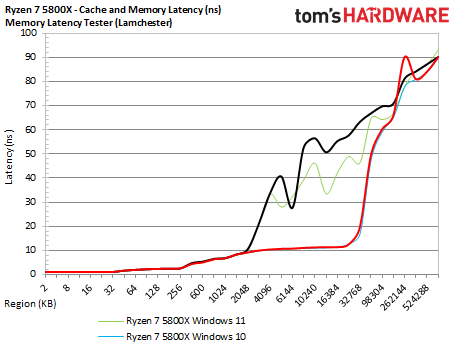
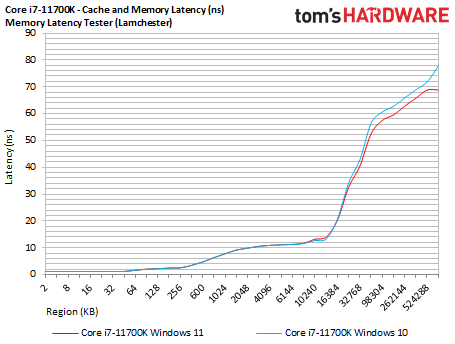
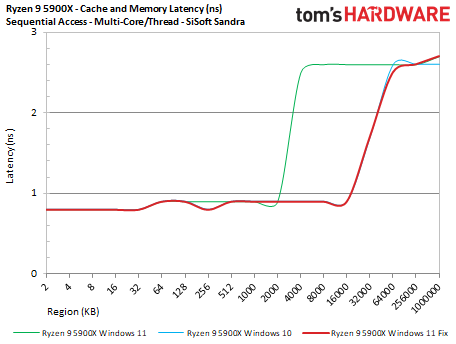

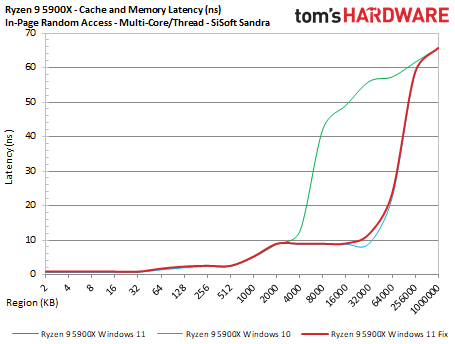

The basic idea behind any on-chip cache is to keep frequently accessed data as close to the execution cores as possible, thus improving performance. The L3 cache is slower than other caches (like L1 and L2), but its higher capacity means it can store more data, thus improving the hit rate (the number of times useful data is held in the cache). There's a reason AMD calls it "Game Cache" — L3 cache is very important to performance, and games in particular can suffer from either high L3 latency or reduced cache capacity.
The first four slides above outline our cache and memory latency benchmarks with the AMD Ryzen 5900X, 5800X, and the Intel Core i7-11700K using the Memory Latency tool from the Chips and Cheese team. These tests measure cache latency with varying sizes of data chunks, and we can clearly see the much higher L3 latency in the unpatched Windows 11 near the center of the chart. In fact, the first Windows 11 update made the issue even more severe, as we can see with the black lines in the first two slides.
We remeasured performance with both the AMD chipset driver and Windows 11 patch for all of our synthetic tests. Our initial in-depth tests measured a ~5X increase in L3 latency for the Ryzen 5000 chips and a 6X increase for the Ryzen 7 3800X. Meanwhile, the Core i7-11700K enjoyed a slightly better cache and memory latency profile with Windows 11.
Our retests found that, aside from minor variations that we can chalk up to standard variability, AMD's L3 latency measurements have returned to normal for this series of tests.
Different benchmark utilities test with unique measurement methodologies, algorithms, and cache strides, so results can and do vary. As such, we turned to SiSoftware's Sandra is used to measure cache and memory latency with three different access patterns, giving us more granularity than a single test and helping to sanity check the results we recorded with the other tools. The last three slides show the results with the 5900X with three different data patterns and generally align with what we've seen in other tests. Again, the recent Windows 11 patch and AMD's chipset drivers have fully corrected the L3 latency issues.
- Sequential access: Almost entirely prefetched into the TLB, making it a good measure of prefetcher performance.
- In-page random: Measures random accesses within the same memory page. It also measures TLB performance and represents best-case random performance.
- Full random: A mix of TLB hits and misses, with a strong likelihood of misses, so it quantifies worst-case latency.
AMD Windows 11 L3 Cache Bug — Bandwidth
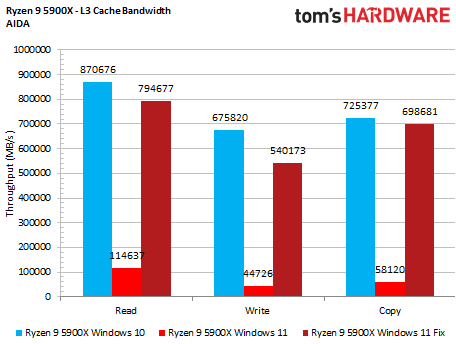
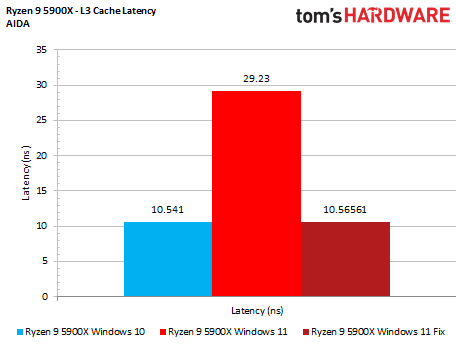
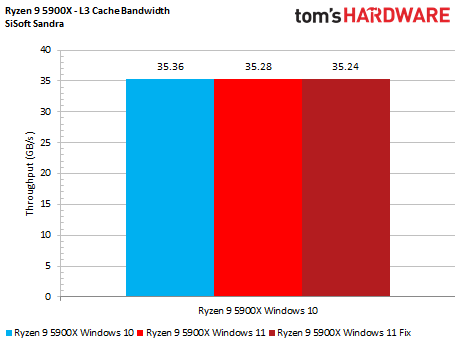
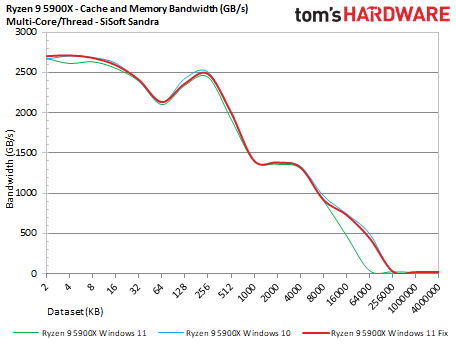

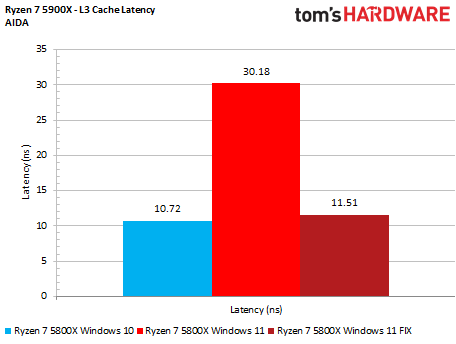

Our first tests of L3 cache bandwidth were quite surprising. AIDA measured 7.5X more L3 read bandwidth, 15X more write bandwidth, and 12X more copy bandwidth for the Ryzen 7 5900X in Windows 10, and similar results with the Ryzen 7 5800X and 3800X. Notably, copy bandwidth is the only measurement of the three that's indicative of application performance.
After applying the patch, we see that the Ryzen 9 5900X regains nearly all of its performance in the copy workload, which, again, is the most relevant metric here. The test still measures a -3.68% performance delta, but that's pretty close to what we would consider standard run-to-run variance for this test. Overall, this is a massive improvement.
The 5800X's L3 bandwidth still lags the Windows 10 measurements by 23%. That represents a substantial improvement, but there's room for more refinement. Due to time constraints, we haven't retested the 3800X yet, but we expect similar improvements.
Again, different utilities use different methodologies, so we also tested with SiSoft Sandra to get a different take on bandwidth. The third slide shows that the 5900X delivers more comparable bandwidth to Windows 11 even with the unpatched Windows 10, highlighting the difference in methodologies and the more general nature of this type of metric. Using the same utility but with a more granular test, we see a marked bandwidth increase from the 8,000 to 25,6000 KB range when we test with the full sweep (fourth slide) compared to our original Windows 11 tests. That indicates there are some improvements in specific access types and regions.

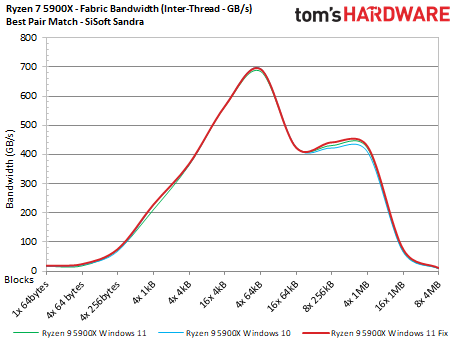
Finally, we used SiSoft Sandra's core-to-core latency and bandwidth test (best pair match) to measure Infinity Fabric throughput with varying data types. For the 5800X, the pre-patched results measured drastically reduced throughput with some data types (green line), and it was reproducible. The Windows 11 and AMD patches largely correct the issue.
Oddly enough, counter to our expectations given that it has more than eight cores, the Ryzen 9 5900X didn't suffer from the same inconsistent performance trend. Its results also remained similar after the patch.
Final Thoughts on AMD Windows 11 Patch Testing
The Windows 11 patch undoubtedly corrected some issues with L3 cache latency and bandwidth, but the profound differences in synthetic measurements simply didn't carry over to most of our real-world gaming tests.
Different games and applications will suffer from cache latency to varying degrees based upon their access patterns and latency sensitivity. Those differences resulted in only one big jump forward of 7.5% in Project Cars 3, but we recorded a performance reduction in Shadow of the Tomb Raider that weighed in at -6.7%.
Bearing in mind that we tested at low resolutions with the most powerful GPU on the market, which would only serve to amplify any measured deltas, we're confident that most users wouldn't notice an impact during a typical gaming session. In fact, when measured as a geometric mean of all of our game tests, the patches were a wash. In the end, performance deltas will vary by title, but it appears we won't see large deltas in the majority of games.
- MORE: Best CPUs for Gaming
- MORE: CPU Benchmark Hierarchy
- MORE: AMD vs Intel
- MORE: All CPUs Content

Paul Alcorn is the Editor-in-Chief for Tom's Hardware US. He also writes news and reviews on CPUs, storage, and enterprise hardware.
-
larkspur ReplyIn fact, when measured as a geometric mean of all of our game tests, the patches were a wash.
Yikes! You guys are gonna take some heat from the AMD fanbois if you end up comparing AMD vs. Intel with both on Win 11 for the upcoming Alder Lake reviews... This certainly won't help with their conspiracy theories anyway! -
Paul Alcorn Replylarkspur said:Yikes! You guys are gonna take some heat from the AMD fanbois if you end up comparing AMD vs. Intel with both on Win 11 for the upcoming Alder Lake reviews... This certainly won't help with their conspiracy theories anyway!
We'll have both Windows 10 and Windows 11. -
tstng Is 23000.258 an insider version? Because if it is, that means the patch is not publicly available? My Windows 11 is 22000.282 and I hammered the "Check for updates" button to no avail. Also, if 23000.258 is an insider version and has nothing to do with the AMD patch (which apparently after a quick search seems to be KB5006746) than you may need to retest because the average user is not using an insider build.Reply -
Conahl Reply
you mean like the uproar the intel fanboys were doing when 11th gen was tested on store bought cpus and boards that were available for sale before intel's official release date ? how they complained about how it isnt the release microcode, and an official release date micro code would put 11th gen ahead of zen 3 ?larkspur said:You guys are gonna take some heat from the AMD fanbois -
tohiliv895 Will amd fanboys still blame the massive gap between alder lake and 5950x because of patch?Reply -
TerryLaze Reply
There isn't going to be any massive gap except for ashes of the singularity and maybe a couple of other outliers.tohiliv895 said:Will amd fanboys still blame the massive gap between alder lake and 5950x because of patch?
Anything else will be just like this patch " win some lose some" -
The_King The concern about the L3 cache issue was about applications sensitive to memory subsystem access time and not really about gaming.Reply
Known Performance Changes
https://www.amd.com/en/support/kb/faq/pa-400
Impact
Resolution
Issue 1: Measured and functional L3 cache latency may increase for some applications.
Applications sensitive to memory subsystem access time may be impacted.
Estimated performance impact of <3-5% in affected applications, with possible outliers in some games. -
tohiliv895 ReplyTerryLaze said:There isn't going to be any massive gap except for ashes of the singularity and maybe a couple of other outliers.
Anything else will be just like this patch " win some lose some"
Wait and see... Wait. And. See. -
renz496 ReplyDanglingPointerException said:Time to switch to linux lads!
wasn't that supposed to happen since vista?
tohiliv895 said:Wait and see... Wait. And. See.
just sit and enjoy the show